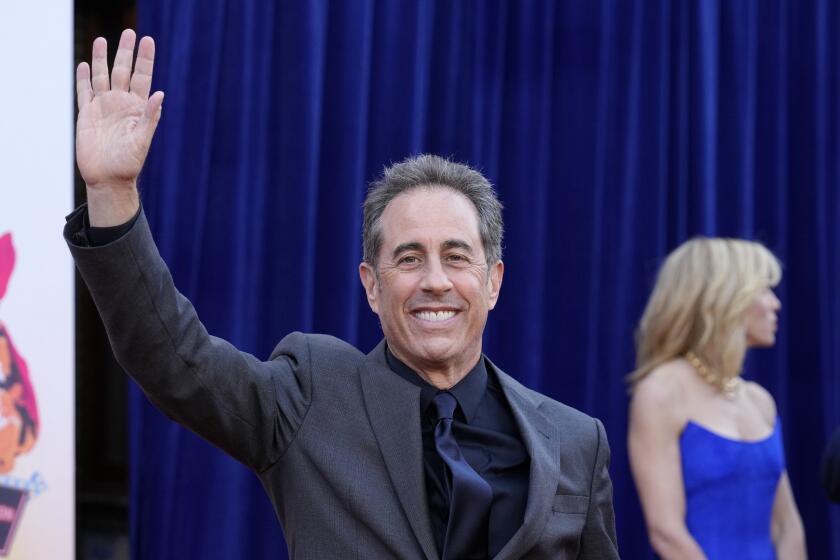Disney Lays Off 90 in Video Game Division
Disney Interactive, a Glendale-based unit of the Walt Disney Co., has laid off 90 permanent employees and an undisclosed number of temporary workers, ending the company’s 3-year-old experiment with producing video games in-house.
The workers were dismissed Tuesday without warning--though rumors had circulated beforehand--and were told to leave by the end of the day, Disney Interactive spokeswoman Amy Malsin said.
Layoffs in the region’s fast-growing entertainment sector may seem an oxymoron, but the cutbacks demonstrate that even the region’s economic golden goose is susceptible to downsizing. The news didn’t surprise most industry insiders.
Those laid off included 3-D animators, programmers and other highly skilled computer graphics professionals, said Steve Hulett, business representative for the Motion Picture Screen Cartoonists and Affiliated Optical Electronic Arts. The union had no contracts at Disney Interactive, but Hulett said he had been contacted by several dismissed workers.
Skilled workers in the computer graphics fields are in high demand but that does not necessarily translate to job security, said Hulett, who like other industry insiders was not surprised by the Disney cutbacks.
“There has been a lot of chaos in the interactive field,” Hulett said. “There was a high expectation of this boom because of so many computers, but it hasn’t jelled the way people thought.”
About 335 workers will remain in Disney Interactive’s modest warehouse-style buildings in Glendale, home to the unit’s retail software business.
Remaining workers interviewed Wednesday seemed stunned and saddened. “I don’t know how many it was,” said one worker, who did not want to be identified. “But it seems like too many.”
Faced with having to boost production costs to keep up with the fast-moving video game market, Disney instead decided to shave its work force. The company will continue to produce video games, but only through license agreements and other development relationships with third parties, Malsin said.
“We are disappointed to see so many talented people exit the company. . . . But this is a volatile industry because of the technology,” she said.
Malsin said the move was needed so Disney Interactive could concentrate on what she called its core business--educational and entertainment CD-ROMS for children, such as its popular “Toy Story” storybook CD-ROMS.
Although Disney has had just a few big hits in the video game market, it has gained a solid hold on the children’s software market, said Bob Peterson, a senior research analyst with the investment bank Piper Jaffray Inc. in Minneapolis.
In that realm, “1996 was the year of Disney,” he said. The company’s share of the $500-million, in-store educational software market rose to 12% last year, making it the third-largest educational software publisher in the country, Peterson said.
Disney Interactive was formed in 1994, incorporating Disney’s existing computer software business. The unit includes Disney’s on-line venture, which employs about 200 people, and was not affected by the cutbacks.
In its short history, Disney Interactive has published a number of successful children’s CD-ROM titles featuring well-known Disney characters.
Disney Interactive has always formed partnerships to produce games, but until Tuesday the company had been doing much of the programming and production work in-house. Among the video games produced in this manner were an Aladdin game in 1994, a Gargoyle and Lion King game in 1995, and most recently the successful “Toy Story” game.
All of these games, however, were produced for an older, 16-bit technology platform, which is fast heading into obsolescence.
“Consumers started moving up to the next-generation games in the middle of last year,” said Allyne Mills, a spokeswoman for GT Interactive Software Corp., based in New York.
Rather than upgrade its production to match the new, more powerful 64-bit games its competitors were producing in the multibillion-dollar industry, the company opted for a lower-risk strategy of parceling out contracting with other firms, Malsin said.
Disney’s decision is representative of the consolidations that have swept through the game industry in the past year.
The industry has been beset with a variety of problems in the past year--rising production costs, limited shelf space and price competition--that has put pressure on publishers, Mills said.
But the Disney cutbacks also reflect an aborted strategy to take over functions once parceled out to companies with solid backgrounds in video-game production and distribution, said Johnny Wilson, editor of Computer Gaming World, a San Francisco-based consumer magazine.
“They never had a long-term commitment to it,” Wilson said. “They have always had a confused strategy that changed every year.. . . I don’t think this is a big surprise.”
More to Read
The biggest entertainment stories
Get our big stories about Hollywood, film, television, music, arts, culture and more right in your inbox as soon as they publish.
You may occasionally receive promotional content from the Los Angeles Times.






